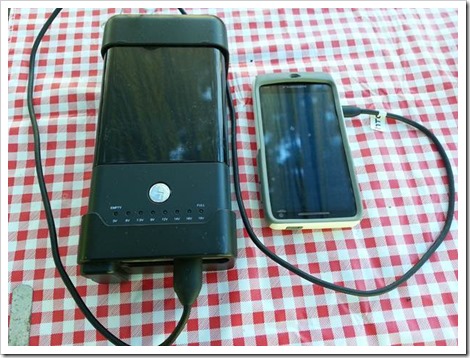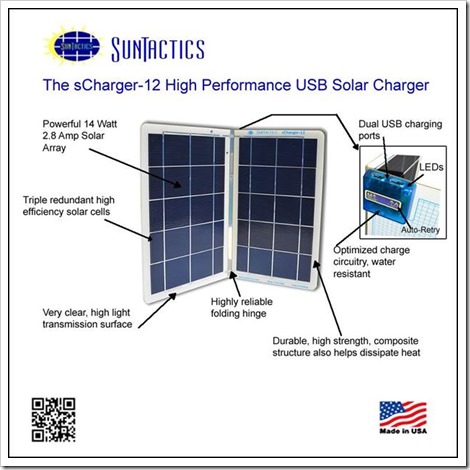The word “power” means many things to folks. When applied to Basic Prepping the mind wanders to wind generators, gas/lp generators, solar cells . . . . there’s a great deal of tech out there designed to give you reliable power in the event your part of the grid goes down.
That said, I find that today the technology that I miss most when power goes away are my primary communication systems – my cell phone, tablets and computer. And, honestly, my Samsung Note II can perform many of my computer tasks – so if I can keep that up and on the air, I’m happy as a clam.
So that’s where I’d like to focus – what is my favorite technology to keep my phone and tablets up and running when I’m on the move and there is no access to “the grid”? My two parameters – it’s needs to fit into my backpack and it needs to provide power for the duration of my trip/trek, regardless of its length.
My most recent trip was a 4-day remote camping trip on a small island off the tip of Door County in Wisconsin named Rock Island. Four families were on the trip with a total of 7 cell phones. (Yes, I know – wilderness is to provide relief from the phone. Yet, when you own your own business and clients expect to reach you 24/7 – well, some of us do not have the luxury of being fully disconnected.) How to keep everyone charged up for the whole trip?
My solution was twofold – a power “brick” and a solar charger.
Power Brick
In June of 2009 my wife and I went to Alaska. It was a “canned” tour, but we went with our best friends, saw as much as we possibly could have in 2 weeks and had a great time. However, being a life-long geek I wondered if there was a way I could provide power to my little netbook during long flight times. I found what I call a Power Brick. Basically, it’s nothing more than a very large lithium-ion battery about the size of a traditional brick. The MP3450 is made by Tekkeon. It has a unique adaptor that allows you to couple two batteries together so the final configuration I carry provides 23,200 mAh of power. Look at that number just one more time . . . .
It was designed to provide a wide range of voltage outputs for a wide range of devices and comes equipped with everything from a cigarette lighter connector to a USB port. I also purchased their adaptor kit and a second battery to create my “Power Brick”. It did a great job powering my little Netbook for well over 15 hours as well as being a backup charger for my cell phone.
If you go to the Amazon link for this product, it really gets hammered. Honestly, I do not know why. Perhaps the folks have not taken time to read the instruction on proper charging. Perhaps it is unreasonable expectations of the product. I can only share that I have had this brick since 2009 and remain satisfied with it.
Prior to my latest trip I fully charged the brick – about a 6 hour process. I packed it in a freezer zip lock (we usually get wet a couple of days), and then simply set it out on one of the tables on the campsite for everyone to use. There were 7 cell phones and an older Kindle. The brick probably charged phones a dozen times with full charges to the phones averaging about 2 hours. As I indicated above, the dual-battery combination provides for 23,200 mAh of power – let’s estimate 20 full charges? Not too shabby.
Price for the dual-battery brick – around $250. For a “prepper” looking for emergency power to keep cell phone and tablet charged, I believe this is a solid alternative that should be considered.
Solar Panel
In years gone by, I created a portable solar system using a Unisol 32W flexible solar panel (long since out of production), a regulator to even out variations in the voltage out of the panel and a storage battery. The system was large and cumbersome – but a fun project. For this last trip I thought that surely there must be some new geek toy out there that I could find as a backup to the Power Brick. Sure enough, there was . . . the sCharger by Suntactics.
This is a 14W charger (they have a 5W as well) with dual USB outputs that provide a regulated output to account for the variations in voltage from the solar panel when light intensity changes. There is no battery attached – the panel charges the tablet, cell phone, iPod, camera directly. Since it is fairly small, it is easily moved as the sun tracks through the sky.
It comes with two USB ports, one with an automatic reset for Apple products. Seems some apple devices frown on using non-apple chargers so they simply stop charging after about 10 minutes. The auto-reset port then detects this and “resets” giving you another 10 minutes of charge time. This process is repeated until your device is charged. The panel charged the iPhones on the trip in about 3 hours in full sun.
My phone is the Samsung Note II and honestly, I wasn’t too happy. I got a 50% charge in about 3 hours off the panel where I would get a full charge in about 2 hours off the Power Brick. Yet virtually everyone else could charge off the panel in about 2 hours. I plan on investigating this since I can see no reason for the panel not fully charging the Note II – I’ll let you know what I find.
While a bit pricy at $240 this is a great option if you spend a lot of time off the grid and need power to charge phones, cameras or tablets. It is well build, comes with a carrying case and room for USB cables and easily fits in my 5.11 Tactical 72-hour Rush pack . . . . along with my Power Brick.
One other thought about power, toys and wilderness travel. Much of your power issues can be handled by better power management. Turn off phone options like gps, WiFi and Bluetooth connections. Dim your display and shorten the time it takes to turn off down to its lowest settings. If you need to touch base with folks back home – establish a communications schedule – say 6AM, Noon and 6PM – anything really, as long as it’s agreed on by both parties, then turn your phone off. These simple choices will go a long way towards reducing your power requirements.
So there you have it. If you are going to spend a substantial time off the grid on a trek or paddle and want a couple of dependable options to provide power for your cell phones and tablets, these two products are what I use. Take some time to check them out. Let me know what you think.





Interesting, but is there a less expensive way, $500 is too pricey for me.
ReplyDeleteYep, the cost is coming down and reliability going up on solar chargers, and that IS a strange one with your unit... Good idea on the comms windows too.
ReplyDeleteBrighid - Suntactics offer a single port charger for about $140. I chose the two port because there were going to be 7 phones . . . and because More Power! :) As for the Power Brick there are a number of cheaper alternatives with 5,ooo mAh packs available for around $50. Take a walk through Amazon and I suspect you'll find something to fit your needs.
ReplyDeleteJim - Costs are coming down but I think they will always be a niche product. They simply are not practical for home consumption. As for not charging the Note II - as soon as I clear the alligators off my desk, I'll have to spend some time to find out what is going on.